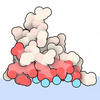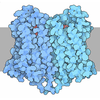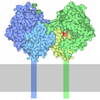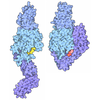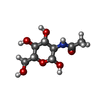+ Open data
Open data
- Basic information
Basic information
| Entry | Database: PDB / ID: 6pxq | ||||||
|---|---|---|---|---|---|---|---|
| Title | Crystal structure of human thrombin mutant D194A | ||||||
 Components Components |
| ||||||
 Keywords Keywords | HYDROLASE / trypsin-like proteases / ionic interaction | ||||||
| Function / homology |  Function and homology information Function and homology informationcytolysis by host of symbiont cells / thrombospondin receptor activity / Defective factor XII causes hereditary angioedema / thrombin / thrombin-activated receptor signaling pathway / negative regulation of astrocyte differentiation / regulation of blood coagulation / positive regulation of phospholipase C-activating G protein-coupled receptor signaling pathway / neutrophil-mediated killing of gram-negative bacterium / Defective F8 cleavage by thrombin ...cytolysis by host of symbiont cells / thrombospondin receptor activity / Defective factor XII causes hereditary angioedema / thrombin / thrombin-activated receptor signaling pathway / negative regulation of astrocyte differentiation / regulation of blood coagulation / positive regulation of phospholipase C-activating G protein-coupled receptor signaling pathway / neutrophil-mediated killing of gram-negative bacterium / Defective F8 cleavage by thrombin / Platelet Aggregation (Plug Formation) / ligand-gated ion channel signaling pathway / positive regulation of collagen biosynthetic process / negative regulation of platelet activation / negative regulation of blood coagulation / positive regulation of blood coagulation / negative regulation of fibrinolysis / Transport of gamma-carboxylated protein precursors from the endoplasmic reticulum to the Golgi apparatus / regulation of cytosolic calcium ion concentration / Gamma-carboxylation of protein precursors / Common Pathway of Fibrin Clot Formation / Removal of aminoterminal propeptides from gamma-carboxylated proteins / fibrinolysis / Intrinsic Pathway of Fibrin Clot Formation / negative regulation of proteolysis / negative regulation of cytokine production involved in inflammatory response / Peptide ligand-binding receptors / Regulation of Complement cascade / positive regulation of release of sequestered calcium ion into cytosol / acute-phase response / Cell surface interactions at the vascular wall / positive regulation of receptor signaling pathway via JAK-STAT / growth factor activity / lipopolysaccharide binding / positive regulation of insulin secretion / platelet activation / response to wounding / positive regulation of protein localization to nucleus / Golgi lumen / Regulation of Insulin-like Growth Factor (IGF) transport and uptake by Insulin-like Growth Factor Binding Proteins (IGFBPs) / positive regulation of reactive oxygen species metabolic process / blood coagulation / antimicrobial humoral immune response mediated by antimicrobial peptide / regulation of cell shape / heparin binding / Thrombin signalling through proteinase activated receptors (PARs) / : / positive regulation of cell growth / blood microparticle / G alpha (q) signalling events / cell surface receptor signaling pathway / positive regulation of phosphatidylinositol 3-kinase/protein kinase B signal transduction / receptor ligand activity / endoplasmic reticulum lumen / signaling receptor binding / serine-type endopeptidase activity / positive regulation of cell population proliferation / calcium ion binding / proteolysis / extracellular space / extracellular exosome / extracellular region / plasma membrane Similarity search - Function | ||||||
| Biological species |  Homo sapiens (human) Homo sapiens (human) | ||||||
| Method |  X-RAY DIFFRACTION / X-RAY DIFFRACTION /  MOLECULAR REPLACEMENT / Resolution: 2.8 Å MOLECULAR REPLACEMENT / Resolution: 2.8 Å | ||||||
 Authors Authors | Stojanovski, B. / Chen, Z. / Koester, S.K. / Pelc, L.A. / Di Cera, E. | ||||||
| Funding support |  United States, 1items United States, 1items
| ||||||
 Citation Citation |  Journal: Sci Rep / Year: 2019 Journal: Sci Rep / Year: 2019Title: Role of the I16-D194 ionic interaction in the trypsin fold. Authors: Stojanovski, B.M. / Chen, Z. / Koester, S.K. / Pelc, L.A. / Di Cera, E. #1:  Journal: EMBO j. / Year: 1989 Journal: EMBO j. / Year: 1989Title: THE REFINED 1.9 A CRYSTAL STRUCTURE OF HUMAN ALPHA-THROMBIN: INTERACTION WITH D-PHE-PRO-ARG CHLOROMETHYLKETONE AND SIGNIFICANCE OF THE TYR-PRO-PRO-TRP INSERTION SEGMENT. Authors: Bode, W. / Mayr, I. / Baumann, U. / Huber, R. / Stone, S.R. / Hofsteenge, J. | ||||||
| History |
|
- Structure visualization
Structure visualization
| Structure viewer | Molecule:  Molmil Molmil Jmol/JSmol Jmol/JSmol |
|---|
- Downloads & links
Downloads & links
- Download
Download
| PDBx/mmCIF format |  6pxq.cif.gz 6pxq.cif.gz | 72.2 KB | Display |  PDBx/mmCIF format PDBx/mmCIF format |
|---|---|---|---|---|
| PDB format |  pdb6pxq.ent.gz pdb6pxq.ent.gz | 51.6 KB | Display |  PDB format PDB format |
| PDBx/mmJSON format |  6pxq.json.gz 6pxq.json.gz | Tree view |  PDBx/mmJSON format PDBx/mmJSON format | |
| Others |  Other downloads Other downloads |
-Validation report
| Summary document |  6pxq_validation.pdf.gz 6pxq_validation.pdf.gz | 459.5 KB | Display |  wwPDB validaton report wwPDB validaton report |
|---|---|---|---|---|
| Full document |  6pxq_full_validation.pdf.gz 6pxq_full_validation.pdf.gz | 462.3 KB | Display | |
| Data in XML |  6pxq_validation.xml.gz 6pxq_validation.xml.gz | 11.8 KB | Display | |
| Data in CIF |  6pxq_validation.cif.gz 6pxq_validation.cif.gz | 14.8 KB | Display | |
| Arichive directory |  https://data.pdbj.org/pub/pdb/validation_reports/px/6pxq https://data.pdbj.org/pub/pdb/validation_reports/px/6pxq ftp://data.pdbj.org/pub/pdb/validation_reports/px/6pxq ftp://data.pdbj.org/pub/pdb/validation_reports/px/6pxq | HTTPS FTP |
-Related structure data
| Related structure data | 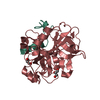 6pxjC 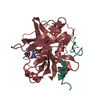 1ppbS S: Starting model for refinement C: citing same article ( |
|---|---|
| Similar structure data |
- Links
Links
- Assembly
Assembly
| Deposited unit | 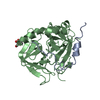
| ||||||||
|---|---|---|---|---|---|---|---|---|---|
| 1 |
| ||||||||
| Unit cell |
|
- Components
Components
| #1: Protein/peptide | Mass: 3791.204 Da / Num. of mol.: 1 Source method: isolated from a genetically manipulated source Source: (gene. exp.)  Homo sapiens (human) / Gene: F2 / Production host: Homo sapiens (human) / Gene: F2 / Production host:  |
|---|---|
| #2: Protein | Mass: 29736.211 Da / Num. of mol.: 1 / Mutation: D194A Source method: isolated from a genetically manipulated source Details: D-A, D194 mutant to A194 WTANVGKG were disordered in the structure. DEGK were disordered in the structure. GE were disordered in the structure. Source: (gene. exp.)  Homo sapiens (human) / Gene: F2 / Production host: Homo sapiens (human) / Gene: F2 / Production host:  |
| #3: Sugar | ChemComp-NAG / |
| Has ligand of interest | N |
| Has protein modification | Y |
-Experimental details
-Experiment
| Experiment | Method:  X-RAY DIFFRACTION / Number of used crystals: 1 X-RAY DIFFRACTION / Number of used crystals: 1 |
|---|
- Sample preparation
Sample preparation
| Crystal | Density Matthews: 2.99 Å3/Da / Density % sol: 58.9 % |
|---|---|
| Crystal grow | Temperature: 295 K / Method: vapor diffusion, hanging drop / Details: 200 mM di-Na phosphate and 20% PEG 3350 |
-Data collection
| Diffraction | Mean temperature: 100 K / Serial crystal experiment: N |
|---|---|
| Diffraction source | Source:  ROTATING ANODE / Type: RIGAKU MICROMAX-007 HF / Wavelength: 1.5418 Å ROTATING ANODE / Type: RIGAKU MICROMAX-007 HF / Wavelength: 1.5418 Å |
| Detector | Type: RIGAKU RAXIS IV++ / Detector: IMAGE PLATE / Date: Jan 16, 2018 |
| Radiation | Protocol: SINGLE WAVELENGTH / Monochromatic (M) / Laue (L): M / Scattering type: x-ray |
| Radiation wavelength | Wavelength: 1.5418 Å / Relative weight: 1 |
| Reflection | Resolution: 2.8→66.63 Å / Num. obs: 10857 / % possible obs: 94.8 % / Observed criterion σ(F): -0.5 / Observed criterion σ(I): -0.5 / Redundancy: 12.2 % / Rsym value: 0.147 / Net I/σ(I): 11.7 |
| Reflection shell | Resolution: 2.8→2.85 Å / Redundancy: 4.6 % / Num. unique obs: 399 / Rsym value: 0.435 / % possible all: 73.9 |
- Processing
Processing
| Software |
| ||||||||||||||||||||||||||||||||||||||||||||||||||||||||||||
|---|---|---|---|---|---|---|---|---|---|---|---|---|---|---|---|---|---|---|---|---|---|---|---|---|---|---|---|---|---|---|---|---|---|---|---|---|---|---|---|---|---|---|---|---|---|---|---|---|---|---|---|---|---|---|---|---|---|---|---|---|---|
| Refinement | Method to determine structure:  MOLECULAR REPLACEMENT MOLECULAR REPLACEMENTStarting model: 1PPB Resolution: 2.8→66.63 Å / Cor.coef. Fo:Fc: 0.929 / Cor.coef. Fo:Fc free: 0.882 / SU B: 28.651 / SU ML: 0.465 / Cross valid method: THROUGHOUT / σ(F): 0 / ESU R: 1.031 / ESU R Free: 0.398 Details: HYDROGENS HAVE BEEN ADDED IN THE RIDING POSITIONS U VALUES : REFINED INDIVIDUALLY
| ||||||||||||||||||||||||||||||||||||||||||||||||||||||||||||
| Solvent computation | Ion probe radii: 0.8 Å / Shrinkage radii: 0.8 Å / VDW probe radii: 1.2 Å | ||||||||||||||||||||||||||||||||||||||||||||||||||||||||||||
| Displacement parameters | Biso max: 195.26 Å2 / Biso mean: 88.695 Å2 / Biso min: 53.85 Å2
| ||||||||||||||||||||||||||||||||||||||||||||||||||||||||||||
| Refinement step | Cycle: final / Resolution: 2.8→66.63 Å
| ||||||||||||||||||||||||||||||||||||||||||||||||||||||||||||
| Refine LS restraints |
| ||||||||||||||||||||||||||||||||||||||||||||||||||||||||||||
| LS refinement shell | Resolution: 2.8→2.871 Å / Rfactor Rfree error: 0
|
 Movie
Movie Controller
Controller



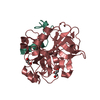
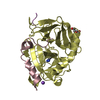
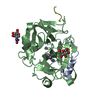

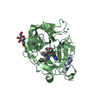
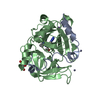
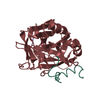
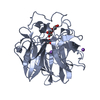
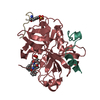

 PDBj
PDBj


